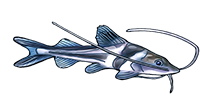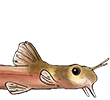Thankyou Sandor, you explained the pigmentation coding process better than I could have. I've always understood the relative high frequency of pigment mutations in fish (leucism, albinism etc.) is due to this particularly vulnerable chain of coding. I'm glad it exist however since the proportion of colour mutants makes for many interesting (yet still naturally occuring) individuals.
Barbie wrote:I still think that brown fry from two albino parents is a result of a cross of a different species of Ancistrus that is the base for the albino strain
nos.[/quote]
Though I agree that sometimes this would be the case, given the likely amalgamation of different species that appear as "common bristlenose", it's still entirely possible for two albinos of the same species to produce brown young - as Sandor explained, colour mutations (in this case albinism) could well occur at several loci for the same species, which may not correspond for two albino parents, giving type-revertant young.
apistomaster wrote:The other possibility is that within the same strain/species that the mutation for albinism arose more than once and at different loci.
I thought you were agreeing with Barbie that brown young from albino parents was the result of hybridization of two differnet albino species of ancistrus, surely this point you make allows for albinos of the same species to produce brown young as Sandor described.
All very interesting, cheers, Conrad.







